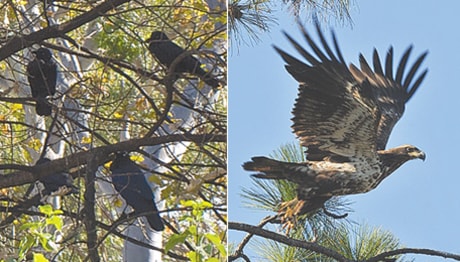A group of us birders saw a really cool sight last fall.
As we were driving along the Delburne Highway, we saw about 20 ravens all gathered in a few trees. Mixed in with them was this humongous blob. I slammed on the brakes, hoping that the big dark thing didn’t turn out to be three ravens sitting close to each other, which is sometimes the case. But not this time.
The blob turned out to be a juvenile bald eagle, which was being “mobbed” by the ravens.
Mobbing is a great way to find birds. Chickadees will mob saw-whets, magpies will mob great horns, and so on.
If you hear a big commotion in the trees, don’t discount it. Check it out. The chickadees might be leading you to a great sighting.
On this particular day, when we stopped the vehicle, the ravens flew off and landed in trees farther away from the eagle.
The eagle, though, didn’t seem to worry that we were there. It stayed there the whole time and we were able to get spectacular looks at it.
I’m not sure if it was a he or a she. I’m leaning a bit towards it being a female, just because it seemed fairly big.
The only difference between a male and a female bald eagle, is size, with the female being bigger that the male.
But size is so subjective.
I remember the first bald eagle I worked with at Medicine River Wildlife Centre. I transported him out there and Carol Kelly commented on how he had to be a male because he was so little.
I had been breathless, thinking it had to be a female because to me, he was gigantic.
Now that I’ve worked with a few eagles, I can tell the difference between the sexes when I have them in the hand, but I still have a problem out in the field.
There, it would be helpful if a male and a female were perched side by side. Then it would be easy to tell which was which.
I’ve always been impressed with these naturalists who can look at an eagle and say definitively that this one is a two-year-old eagle and that one is a four-year-old eagle.
I usually can’t do that, but I was quite pleased that we were able to tell the age of this one with quite a bit of certainty.
We knew this one was a juvenile because it didn’t have a full white head or tail.
They don’t get those until they are four or five years of age.
But this one had quite a bit of white in the head and tail so we figured it was about a three year old.
It looked exactly like the picture of a three-year-old bald eagle in our bird books.
As we watched this magnificent bird in this tree, it rubbed its beak along the tree branch it was perched on.
This is called “feaking” and it is a way for birds to keep their beaks in condition. Someone told me one time that this bill rubbing was a courtship ritual.
I’m not sure about that. I haven’t been able to find any literature that corroborates that supposition. But perhaps it is true in some cases. This certainly wasn’t the case here.
This bird had not reached sexual maturity, it was the wrong season, and there were no other eagles in the vicinity to be courted. Three strikes! You’re out!
For some in the car, it was a first good look at a bald eagle. For others, it was simply a great look at a bird that we were familiar with.
We have quite a few bald eagles that stay with us over winter, so perhaps this won’t be our last good look of the season.
Judy Boyd is a naturalist with the Red Deer River Naturalists.
